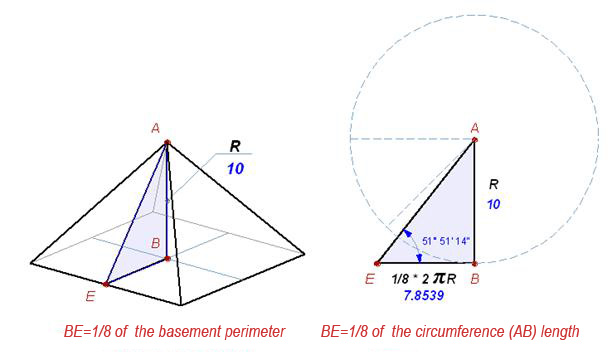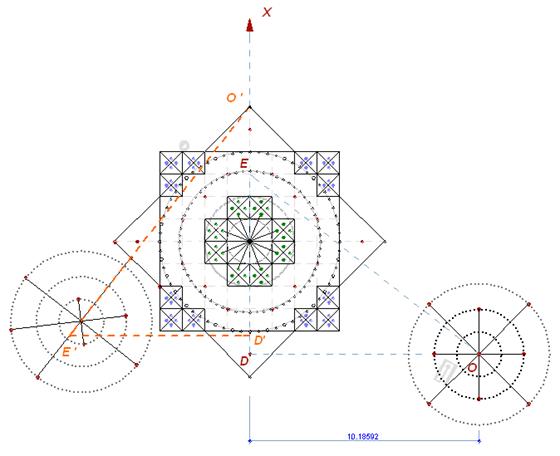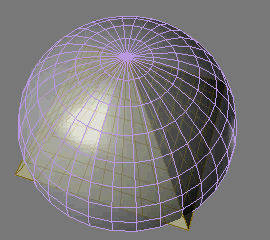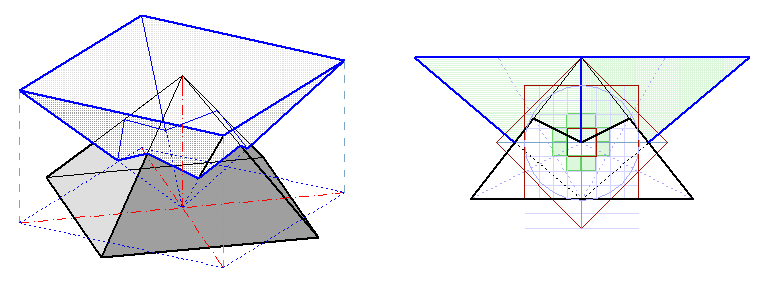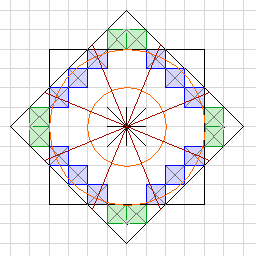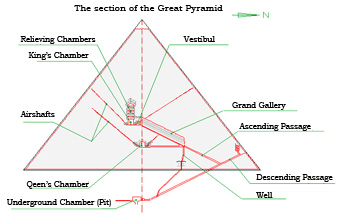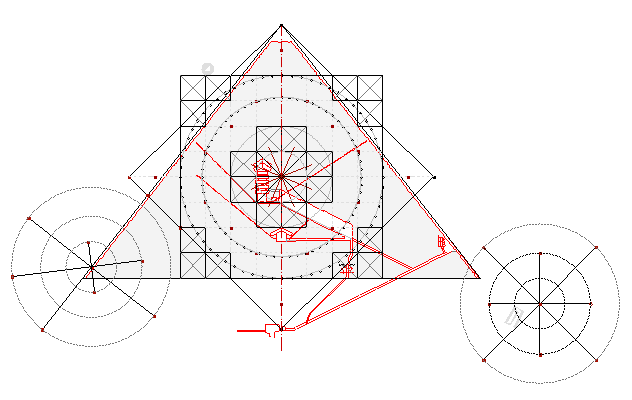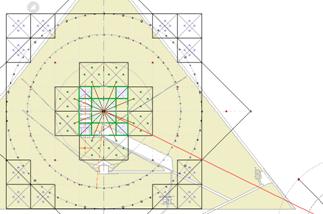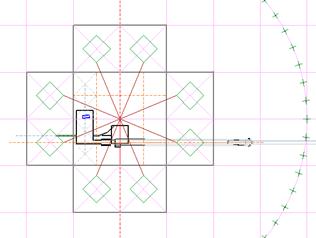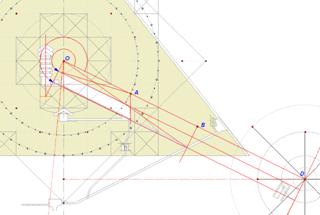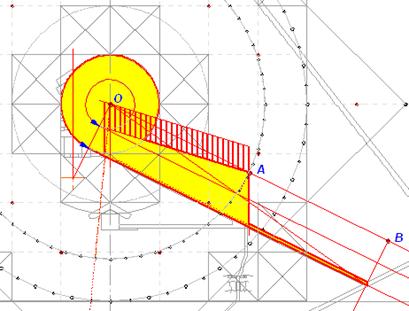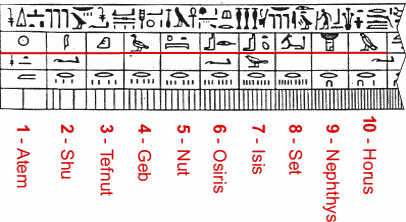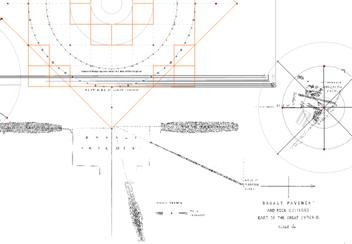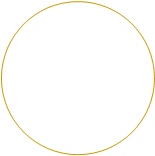

|
“Estrella” - composition analysis |
|
Ggeoglyphs in the Nazca mountains - is it just a simple ornament or the plan |

|
Chapter 5. Pyramid with a square base. |
|
V. Kulikov |
|
The time has come to connect the third dimension. The fact is, that the 4-sided pyramid is a very convenient and compact representation of the ratio between the radius and circumference length. It will be enough to put the radius of the circle with the perimeter of the square to the center of the square in order to get a pyramid, with very important properties. Even until our times, the unexplained wonders are still occurring inside the pyramids with such proportions: somehow the pyramids can affect on the different samples of material and non- material world, placed inside of them.
Fig. 1 The group of these left circles indicates on the triangle, which in it's turn, is the half-section of the Pi-pyramid.
Fig. 2 (from Chapter 4)
Naturally, there is a desire to talk about the opportunity of appearing of a vertical projection of the the depicted problem on the Estrella geoglyph. 1. A clear indication to an angle, close to 52 °, which indicates on the volumetric representation of the relations between the perimeter and radius, and thus the diagonal square of the star is connected. 2. The right group of the circles indicates on the big circle, located not in the center of a star, but somewhere aside of it. We don't see the image of it. Maybe we don't watch it on the geoglyph, because it lies in the plane surface of the base, and its image merges into a line, while its length DX runs vertically across the top of O' ? The second group of the circles also moves along the "height", ignoring the symmetry of the general "plan". 3. The diagonal square of the star, almost did not take part in the 2D topics, that we have already discussed. It just has designated on the problem of the octagonal star. 4. The similar views of a cube, square, circle and sphere on a plane. I think it would not be much surprising, if we shall talk about the geoglyph, as about the scheme, which combines different projections of the 3D system. It is a certain conglomerate, which is explaining the principles of the volumetric composition, and interaction of its internal elements.
Fig. 4 Such a model is just a hypothesis, but the point of intersection of these volumes, strangely coincides with the center of the square, along the height, where the "active area" of the star is located. If we go back to the beginning, we shall see, that the diagonal square acts as a catalyst, leading the system to changes. This diagonal square leads to the appearance of an octagon, that rearranges the square into a polar system. The difference between the polar and orthogonal system, is: that the polar system is built on the principle of equidistant of identical values from the center position (the angle value is important). The values of the rectangular system, are located along the axis (linear value). So, in the orthogonal system, we can move a segment along the length of the axis, and it will not change its size, keeping the proportional equality with the other variables of the system. In the polar system, the distance from the center leads to the changing of its angular size, which violates the proportionality.
Rising up to the top of the pyramid, from inside of it, the modular grid of the basement must decrease proportionally, keeping the number of cells the same (Fig. 3). But this contradicts with the orthogonal nature of the square. The space of the cell changes, the advantage of the rectangular system is lost, but the equidistance of the cells from the center - is not achieved. Such pressing of the internal structure inevitably rises the internal stresses, and, in its turn, leads to the internal resistance. In such conditions, it is not difficult to assume the emergence of the "spatial double-antipode" a kind of antibody, balancing or compensating the incorrect "shrinkage" of the spatial cell. This antipode may be the inverted pyramid, rotated on a quarter of a circle, which adds the orthogonal system the interaction with the polar system ( we get an octagon at the intersection of these two pyramids).
But those, who built the Great Pyramid of Giza, obviously, possessed this knowledge. It is well-known fact, that it's external form is consistent with the proportions of the Pi-pyramid. The internal structure of the Great Pyramid, in it's turn, remains the mystery until today. The attempts to explain the location of it's chambers, passages, and structures, not subservient to our logic - still continue. The functional purpose of the whole pyramid is still a matter of many debates. It is quite difficult even to suggest, that this absolutely not adapted for the human purposes structure, was erected by the people, who just have mastered agriculture and handcraft in the new State. It is also difficult to suggest, that the «Estrella» drawing was created by the local ancient Indian's tribes, for the amusement of the gods, with a selfish desire to ask for the rain or other vital benefits.
Fig. 7 It is considered, that the height of the pyramid makes 280 Egyptian Royal Cubits (Royal Cubit 523.75 mm + - .25). With such a scale, the modular cell will be equal to 28 RC. From the position of the metric, this size is interesting by that fact, that the cubit in the Ancient Egypt was divided into 28 parts (the fingers, which were grouped into seven palms of 4 fingers each). The story of the elbow (cubit) looks quite funny, when we consider, that the royal elbow did not change in Egypt (the anthropomorphic case). And also various peoples in the rise of civilization (the Sumerians, Druids, Egyptians, Aztecs, and even the ancient Chinese (http://www.worldwideflood.com/ark/noahs_cubit/cubit_references.htm) had the similar size of their elbows (with a difference not more, than 15 mm!). ( I wonder, where standardization committee was located?). But the most important fact, in my opinion, is not even the proportional system, which is so successfully combined within these objects, but the way, how the main elements of the Great Pyramid are located in different areas of of the Estrella scheme. I shall identify these zones absolutely symbollicaly, because the quantum physics and the theory of the curvature of space gravity - is "not my strong point". So, futher is a little more from the "mystical astrologer":
I can not say exactly what for, from the functionally point of view, all these relations between the cells and the length of the circumference of the polar system are associated with the Grand Gallery and the Passage, but this relation exist, and I think, it plays the important role in the construction of the pyramid. The dimensions of the Gallery are based on the modular lengths of the circles. Taking the start in a strange vestibule, the rather active circle (formed by the marking cells) is "unwinding" inside the segment, equal to OB, which is located along the whole length of the Ascending Passage. The smaller circle, with the diameter of 1 - unwinds to the segment OA, which is corresponding to the length of the ramp and the roof of the Grand Gallery. I'll not going to judge whether these coincidences are related to the wavelengths or the cell-quantums of the square, being "reforged" into the polar system, but the interaction between these two schemes is clearly visible.
The linking of the proportional system of the Estrella and the Great Pyramid drawings - is a separate topic to discuss. The small variations of the modular grid is available here, because the absence of the pyramid's casing and the pyramidion (the top of the pyramid) do not allow to ascertain the exact origin of the coordinates. Another possible way to calculate the pyramid's heigh is to do it from the "blind area" or from the level of the angular grooves in the bedrock. The grid may also be "binded" to the floor of the King's Chamber or to the the marks of the Airshafts and tops of the Passages. But these theoretical questions are left for the further study. The slight variations are not quite significant within the overall scheme of general composition. The drawing is a hybrid projection, combining the idea of placing the elements on the general plan, on the 2D projection, and the functional schemes. The "coincidence" of the location of the basalt platform at the eastern side of the Great Pyramid of Giza is not surprising anymore:
I mentioned these "coincidences" as an illustration of the fitting of the proportions and functional zoning of the drawings of the Great Pyramid and Estrella, located on the different sides of the planet. The professionally executed "master plan" is surprising... It's main idea, it's zoning, it's basic relations, it's basics proportional ratios - all this multi-layer package of information is represented in the form of an aesthetic pattern, with the beautiful name "Estrella". The elements of the geoglyph, as well as the elements of the pyramid are located within the single logic, and as a result - according to the single geometry. I believe that the geoglyph is related to the device, built in Egypt on the Giza plateau. If the Estrella drawing is the concept scheme of the working pyramid, maybe it is possible to find some clues to understanding the purpose of this wonderful Egyptian construction. These two objects are also much close in aesthetic asceticism and rigorous precision of mathematical ratios. The level of the complex structural logic of the self-regulating system with it's brightly explicit demonstration purpose, is much close to the concise and accurate structural components of the Great Pyramid with it's carefully designed internal architecture and, at the same time, for the thousands of years, remaining the most grandiose building on the planet. After all , what is interesting , the attracting of attention - is one of the rather subtle and subjective aspects of the human psychic. This fact was definitely taken into account, while designing and constructing of these two great objects. The apparent simplicity, which seems from the first glance, reveals as a complex system of relations: it's also the height of the perimeter of a circle in a pyramid, or the connection of the pyramid's side with the minute of the Earth's equator, or it is the marking points - holes in the ground, spread over the kilometer area. And unlike the traditional concepts of all known civilizations, the attention is attracted not by the Pharaohs statues and colorful paintings, but by the apparent simplicity of the unpretentious objects, which after the close look are disclosing and attracting us with their hidden mysteries. There are more questions left, than the answers are found...
|
